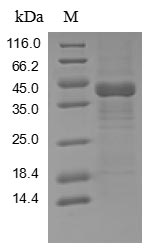The expression region of this recombinant Human TAB2 covers amino acids 401-693. This TAB2 protein is theoretically predicted to have a molecular weight of 37.1 kDa. The TAB2 protein was expressed in baculovirus. The N-terminal 10xHis tag and C-terminal Myc tag was fused into the coding gene segment of TAB2, making it easier to detect and purify the TAB2 recombinant protein in the later stages of expression and purification.
TGF-beta-activated kinase 1 and MAP3K7-binding protein 2 (TAB2) is a protein of significant research interest. Its studies focus on signal transduction and immune regulation. TAB2 plays a crucial role in the TGF-beta signaling pathway, regulating cellular processes such as proliferation, differentiation, and apoptosis. In the area of immune regulation, TAB2 is involved in modulating inflammatory responses and immune cell functions. Recent studies suggest a potential association of TAB2 with the onset and progression of tumors. This positions TAB2 as a key molecule in research areas such as immunology, cancer, and signal transduction.






